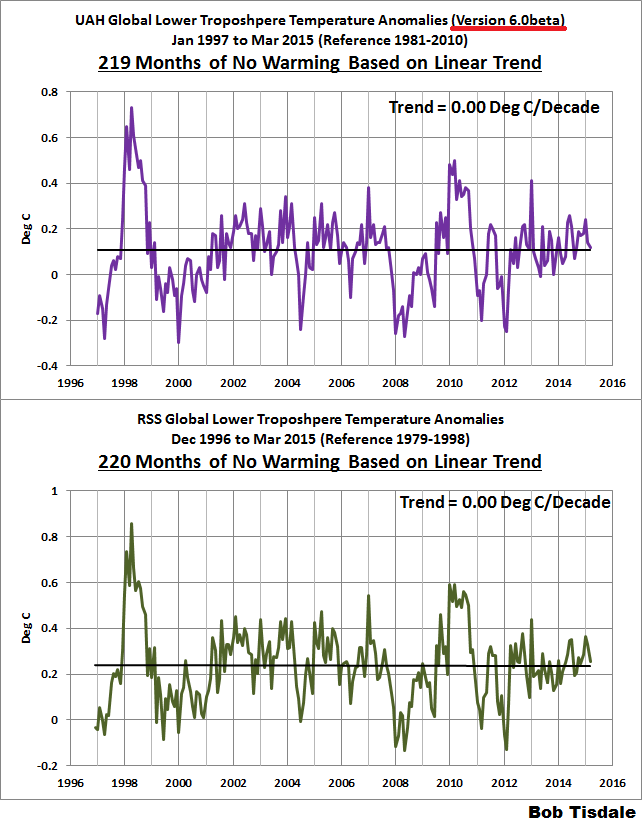This is satellite data, not the frequently-and-mysteriously adjusted surface data. But I'm pretty unhappy after digging into the details and finding out that this data is adjusted, too:
One might ask, Why do the satellite data have to be adjusted at all? If we had satellite instruments that (1) had rock-stable calibration, (2) lasted for many decades without any channel failures, and (3) were carried on satellites whose orbits did not change over time, then the satellite data could be processed without adjustment. But none of these things are true. Since 1979 we have had 15 satellites that lasted various lengths of time, having slightly different calibration (requiring intercalibration between satellites), some of which drifted in their calibration, slightly different channel frequencies (and thus weighting functions), and generally on satellite platforms whose orbits drift and thus observe at somewhat different local times of day in different years. All data adjustments required to correct for these changes involve decisions regarding methodology, and different methodologies will lead to somewhat different results. This is the unavoidable situation when dealing with less than perfect data.This makes me grumpy.
I don't like adjustments to data, and I don't like accepting them because I like the scientists better or because the results agree with my world view. And the changes seem (to me, anyway) pretty significant:
Bah. Need to think about this and read more of the fine print. In the meantime, can everyone please just stop fiddling with the data?

I don't have a problem with fiddling with the data. It's part of the job. But I bloody well want to see the raw source data, and why and how it was fiddled with.
ReplyDeleteThere's a reason they beat the "show your work" drum in school.
Say it isn't so, Borepatch! Say it isn't so!
ReplyDeleteI'm with Dave H with one little extra. I'll let you adjust your data once. Maybe twice, if you really, really, really convince me you need to, but then NO MORE.
ReplyDeleteIt may not be dishonest, but it looks corrupt as hell.
Electronic instruments are typically recalibrated yearly (or so). They need it; components drift. And most of the time being a bit out of calibration is not going to hurt anything; for example, an oscilloscope used to troubleshoot computers. Who cares if it says 3.1 V when it really is 3.0 V? It's digital.
ReplyDeleteWith the global warming issue, everything is backwards. Small amounts one way or the other are very significant, yet recalibration is almost impossible. And the way things are recalibrated are also not value-free; if you go one way your funding goes up; if the opposite way your funding goes down. There are just so many things that can go wrong in this picture I can't see why anybody trusts this data.
Figures lie and liars figure... again, still... sigh
ReplyDeleteI'm with Dave H. Adjustments are fine, but make the raw data available, and show your work (and not just how, but why). That way, if someone disagrees, they can run their own analysis with the raw data, or with different adjustments, and publish it for others to see.
ReplyDeleteThat's how science is supposed to work.